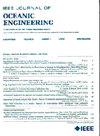A Dense Subframe-Based SLAM Framework With Side-Scan Sonar
IF 3.8
2区 工程技术
Q1 ENGINEERING, CIVIL
引用次数: 0
Abstract
Side-scan sonar (SSS) is a lightweight acoustic sensor commonly deployed on autonomous underwater vehicles (AUVs) to provide high-resolution seafloor images. However, leveraging side-scan images for simultaneous localization and mapping (SLAM) presents a notable challenge, primarily due to the difficulty of establishing a sufficient number of accurate correspondences between these images. To address this, we introduce a novel subframe-based dense SLAM framework utilizing SSS data, enabling effective dense matching in overlapping regions of paired side-scan images. With each image being evenly divided into subframes, we propose a robust estimation pipeline to estimate the relative pose between each paired subframe using a good inlier set identified from dense correspondences. These relative poses are then integrated as edge constraints in a factor graph to optimize the AUV pose trajectory. The proposed framework is evaluated on three real data sets collected by a Hugin AUV. One of these data sets contains manually annotated keypoint correspondences as ground truth and is used for the evaluation of pose trajectory. We also present a feasible way of evaluating mapping quality against multi-beam echosounder data without the influence of pose. Experimental results demonstrate that our approach effectively mitigates drift from the dead-reckoning system and enables quasi-dense bathymetry reconstruction.基于侧扫声纳的密集子帧SLAM框架
侧扫声纳(SSS)是一种轻型声传感器,通常部署在自主水下航行器(auv)上,用于提供高分辨率海底图像。然而,利用侧扫图像进行同步定位和制图(SLAM)提出了一个显著的挑战,主要是因为难以在这些图像之间建立足够数量的准确对应关系。为了解决这个问题,我们引入了一种新的基于子帧的密集SLAM框架,利用SSS数据,在成对侧扫图像的重叠区域实现有效的密集匹配。在将每个图像均匀划分为子帧的情况下,我们提出了一种鲁棒估计管道,利用从密集对应中识别出的良好内嵌集来估计每个成对子帧之间的相对姿态。然后将这些相对姿态作为边缘约束整合到因子图中,以优化AUV姿态轨迹。在Hugin AUV收集的三个真实数据集上对所提出的框架进行了评估。其中一个数据集包含手动注释的关键点对应作为地面真值,并用于姿态轨迹的评估。提出了一种不受位姿影响的多波束测深数据成像质量评价方法。实验结果表明,我们的方法有效地减轻了航位推算系统的漂移,实现了准密集的测深重建。
本文章由计算机程序翻译,如有差异,请以英文原文为准。
求助全文
约1分钟内获得全文
求助全文
来源期刊

IEEE Journal of Oceanic Engineering
工程技术-工程:大洋
CiteScore
9.60
自引率
12.20%
发文量
86
审稿时长
12 months
期刊介绍:
The IEEE Journal of Oceanic Engineering (ISSN 0364-9059) is the online-only quarterly publication of the IEEE Oceanic Engineering Society (IEEE OES). The scope of the Journal is the field of interest of the IEEE OES, which encompasses all aspects of science, engineering, and technology that address research, development, and operations pertaining to all bodies of water. This includes the creation of new capabilities and technologies from concept design through prototypes, testing, and operational systems to sense, explore, understand, develop, use, and responsibly manage natural resources.
 求助内容:
求助内容: 应助结果提醒方式:
应助结果提醒方式:


